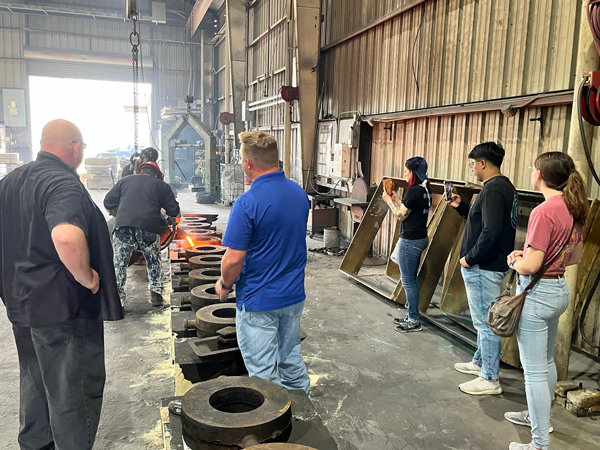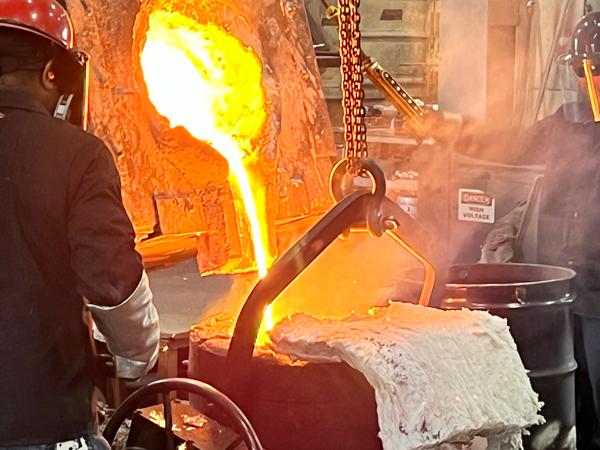Lamar University student group receives Superior Pattern Works foundry tour
May 13, 2022 | by Natalie Frels-Busby
An interdisciplinary group of Lamar University students toured Superior Pattern Works on Wednesday, May 4. The tour was in association with the Lamar Student Chapter of the Institute of Industrial and Systems Engineers (IISE) and the Art and Design Department’s Artist Common student organization. The tour was organized by Kurt Dyrhaug, associate professor from the Art and Design Department, and Robert Kelley Bradley, associate professor from the Department of Industrial and Systems Engineering.
Jesse Stinson, general manager, led the tour and explained the process. According to Stinson, cast metal parts start with a wood pattern. The pattern is covered in specially treated sand that hardens and maintains it shape even after the wood pattern is removed. When put together, two mold halves, made from sand, define a 3-dimensional hollow space. It is into this cavity that molten metal is poured to form the final part.
"Stinson explained each step,” said Andrea Wion, a senior majoring in industrial engineering and the president of IISE, “We were able to see first-hand how engineering and art are linked through design and process optimization."
Stinson explained, “Foundry work is about pouring metal at the lowest temperature possible and at the right speed.”
The students learned that achieving this goal requires careful design. Modern technology is used to optimize the age-old process of foundry work, for example, wood patterns are fabricated on CNC machines, molds are designed using Finite Element Analysis and Computational Fluid Dynamics and spectroscopy is used to determine elemental composition of castings.
The high point of the tour, according to attendees, was seeing the metal pour. Workers guided a crane hoisted crucible and carefully poured the metal into the mold. Once the metal cools the sand is knocked loose and collected for reuse. The metal part is cleaned up by removing sacrificial elements such as the raisers and by grinding and smoothing along the seam.
“It was cool to see from an artist perspective, how a foundry can be used to cast manufacturing parts in different metals and not just beautiful sculptures,” said Javier Merino, a junior majoring in studio art with a concentration in sculpture.
“We are very grateful to Stinson and Keen for giving us the opportunity to learn from them,” said Bradley, “they have a tremendous amount of expertise in this field.”
Ted Keen, president of Superior Pattern Works, has been operating the foundry since 1985. Stinson’s family-owned Standard Alloys in Port Arthur, where he started learning foundry work at a very young age.
Superior Pattern Works in now one of only a few industrial foundries operating in the region and plays in critical role in supplying a wide range of customers with cast metal parts.
“Seeing any business operations really enhances a student’s understanding of the job market and what to expect after graduation,” said Dyrhaug. “A foundry like Superior Pattern Works involves many aspects of mathematics, engineering, chemistry, new technology, and problem solving to maintain profitability. Lamar University is very fortunate to have partners like Ted Keen and Jesse Stinson working with our students and faculty.”
Jesse Stinson, general manager, led the tour and explained the process. According to Stinson, cast metal parts start with a wood pattern. The pattern is covered in specially treated sand that hardens and maintains it shape even after the wood pattern is removed. When put together, two mold halves, made from sand, define a 3-dimensional hollow space. It is into this cavity that molten metal is poured to form the final part.

"Stinson explained each step,” said Andrea Wion, a senior majoring in industrial engineering and the president of IISE, “We were able to see first-hand how engineering and art are linked through design and process optimization."
Stinson explained, “Foundry work is about pouring metal at the lowest temperature possible and at the right speed.”
The students learned that achieving this goal requires careful design. Modern technology is used to optimize the age-old process of foundry work, for example, wood patterns are fabricated on CNC machines, molds are designed using Finite Element Analysis and Computational Fluid Dynamics and spectroscopy is used to determine elemental composition of castings.
The high point of the tour, according to attendees, was seeing the metal pour. Workers guided a crane hoisted crucible and carefully poured the metal into the mold. Once the metal cools the sand is knocked loose and collected for reuse. The metal part is cleaned up by removing sacrificial elements such as the raisers and by grinding and smoothing along the seam.
“It was cool to see from an artist perspective, how a foundry can be used to cast manufacturing parts in different metals and not just beautiful sculptures,” said Javier Merino, a junior majoring in studio art with a concentration in sculpture.

“We are very grateful to Stinson and Keen for giving us the opportunity to learn from them,” said Bradley, “they have a tremendous amount of expertise in this field.”
Ted Keen, president of Superior Pattern Works, has been operating the foundry since 1985. Stinson’s family-owned Standard Alloys in Port Arthur, where he started learning foundry work at a very young age.
Superior Pattern Works in now one of only a few industrial foundries operating in the region and plays in critical role in supplying a wide range of customers with cast metal parts.
“Seeing any business operations really enhances a student’s understanding of the job market and what to expect after graduation,” said Dyrhaug. “A foundry like Superior Pattern Works involves many aspects of mathematics, engineering, chemistry, new technology, and problem solving to maintain profitability. Lamar University is very fortunate to have partners like Ted Keen and Jesse Stinson working with our students and faculty.”